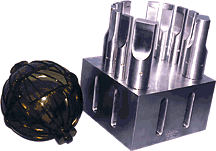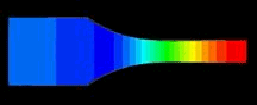Basic horn shapes are cylinders, stepped and tapered cylinders, rectangular/square block, stepped block/bar horns and several designs with fancy names like catenoidal, exponential, variations of a stepped cylinder. In almost all cases the parts and operation required dictate the shape of the horn. When looking at a horn shape try to think of musical instruments, brass mostly, and how sound will travel. Most important, consider the shape of the horn when projects are in the design stage.
Large composite block horn for welding complex geometries.


Part surfaces with intricate contour are difficult to machine in horn faces. Careful consideration of the horn face and its relationship to the part surface is extremely critical. Flat uniform contact surfaces are always preferred. Large cylindrical, block and bar horns almost always incorporate slotting. Slotting or segmenting large horns is primarily used to maintain even vertical amplitude throughout the horn. Large slotted horns should be observed through a microscope in several places to verify even vertical displacement.
Need More Information?
Get it Here.